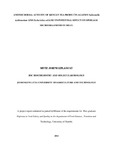| dc.description.abstract | Meat is a highly perishable food due to its highly nutritive value for microbes. It is therefore prone to the growth of various microorganisms which causes adverse health effects as well as food spoilage leading to economic loss.Previous studies have shown that tea possesses antimicrobial activity against many pathogenic microorganisms including Gram-positive bacteria such as Listeria spp. and Staphylococcus aureus. Green tea and black tea contain compounds such as catechins, theaflavins and polyphones which according research are potentially antimicrobial. The aim of this study was to establish tea as a potential preservative for food vulnerable to spoilage such as meat. The tea extracts were prepared through general infusion method. Moreover the antimicrobial activity was determined using the agar-well diffusion method and paper disc diffusion methods. The growth inhibition by green tea and black tea extracts against Salmonella typhi and Escherichia coli was determined by measurement of the diameter of inhibition halo. The potential preservation of meat was determined through total plate count analysis on samples treated with green tea and black tea extracts and control samples without any treatment.
Four tea blends of green tea and black tea were selected from the major tea processing companies in kenya. The blends were labelled A (Unilever Tea), B (Finlay tea), C (KTDA) and D (Sasini tea). Tea extracts were obtained from these blends and were tested against Salmonella typhimurium and Escherichia coli as well as other spoilage microorganisms in meat. The results showed that Black tea extract from blend B (Finlay tea) showed highest zone (11.67±0.33) mm of inhibition while tea extract from blend D (Sasini tea) showed the lowest zone (9.67±0.88) mm of inhibition. Against Escherichia coli, black tea extract from blend A (Unilever tea) showed had the highest (13.67±0.33) mm inhibition zones while extract from blend D (Sasini tea) showed the lowest (11.67±0.33) mm inhibition zones. Green tea extracts
x
from blend A (Unilever tea) and D (Sasini tea) showed highest growth inhibition against Salmonella typhi with measurements of 14.67 mm and 14.33 mm respectively while tea blend B (Finlay tea) showed the lowest growth inhibition. Against Escherichia coli, extract from blend C (KTDA) showed highest inhibition (16.00 ± 0.58) mm while the lowest was from blend B (Finlay tea) with measurement of (14.67 ± 0.33) mm. There was significant reduction (P<0.05) of the microbial counts between control samples and samples treated with green tea and black tea extract. However, on comparing the microbial counts between 4hrs and 8 hrs after treatment, the results showed that there was no significant difference at (P>0.05). i.e. (3.8 cfu/ml and 4.4 cfu/ml) and (3.7 cfu/ml and4.4 cfu/ml) respectively. This was also observed in the innoculated meat samples where meat sample treated with green tea extract had (4.8 cfu/ml and 4.7 cfu/ml) and that treated with black tea extract had 6.0 cfu/ml in both 4hrs and 8hrs after treatment. Generally there was a higher antimicrobial activity of both green tea and black tea against E. coli as compared to S.typhi.For instance, black tea extract from blend C (Sasini tea) had a higher inhibition against S.typhi as compared to E.coli. Polyphenolic compounds are the major components found in tea and are the major contributors to the antimicrobial effect of tea. Against both microorganisms, the relationship was stronger in black tea than in green tea. The effect of black tea and green tea was much stronger against E.coli than S.typhi. Meat spoilage usually begins from the surface going inwards. Through surface treatment using the tea extracts on the meat samples, there was reduction in microbial growth of the spoilage microorganisms in the meat samples. This shows that tea extracts have an antimicrobial effect on the spoilage microorganisms that are found on meat. It can be concluded that both green tea and black tea extracts from the different tea blends showed no significant difference in their antimicrobial activity against both S.typhi and E.
xi
coli with blend B (Finlay tea) and C (KTDA tea) showing similar growth inhibition against E.coli. However, the data may offer the consumer a choice of tea brands with very high antimicrobial properties against S.typhi and E.coli.
The strong relationship between polyphenol levels and antimicrobial activity is an indication that the antimicrobial activity of tea is determined by the levels of polyphenols in the tea product. Since the meat samples treated with green tea and black tea extracts showed lower microbial counts compared to the control, they could be used for controlling growth of spoilage microrganisms of foods such as meat. | en_US |

